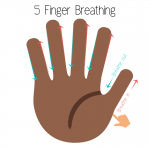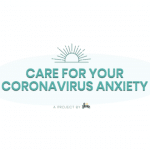
Last week, the 8-year-old that I care for burst into the room and clung onto my legs. She sobbed, “I don’t want mommy and daddy to have COVID.” Her dad had shown symptoms that morning, and her parents, both doctors, were on their way to get tested. Her worry had become so big that it overtook the sense of humor she’d been cultivating recently — fake coughing on her sibling to give her coronavirus, licking my spoon in between bites of ice cream and sniggering, and other ways to mask the real fears that come with this moment.
All of us are coping in our own ways — as individuals, as family units, as neighborhoods, as towns. Sometimes we don’t even know what we’re feeling until it bursts out of us and we start looking for legs to cling to. This Screen-Free Saturday, take the emotional pulse of yourself and your family. Unplug to hug, to cry, to laugh, to connect. Unplug to feel.
Activity Ideas
During the work week, I am not only buried in screen-heavy work, I think I’ve buried many of my feelings in my screen time. Many of us adults use screen time to cope, and often to meet new child care needs (like allowing extra screen time for our kids in order to get stuff done or to have a moment to ourselves). Whatever your habits during the week, use Screen-Free Saturday as a time to check in about your family’s overall and digital wellness, and to practice and model other ways to be with difficult emotions.
TAKE A PULSE CHECK: Before Saturday, take the Digital Flourishing survey from our colleagues at Digital Wellness Collective to get a sense of where you are in your relationship with technology. Use the results to talk with your family about how things are going and what you might change.
GET GROUNDED: “Self-regulation” is the word we use to describe how we can calm our emotions when we’re feeling all of our feelings. Kids need the grown-ups around them to model and teach them explicitly how to self-regulate — and some of us adults could use a reminder, too!
Breathing exercises: Have you heard of Five Finger Breathing? Breathing up and down while tracing your fingers can help to calm your nerves. It’s a great, concrete tool for kids!

Create a calm space: Sometimes we benefit from a physical space that helps us say “ahhh.” For my 8-year-old friend, this is under her bed, where she keeps a light-up peg board, a few books, and a flashlight. CCFC staff member David’s daughter has a lawn chair and some crafts under their porch. Even in my small studio apartment, I will occasionally string a big blanket over my couch and tuck myself into a temporary calm space. In your kiddo’s space, include activities and ideas for self-regulation, like breathing or yoga prompts, a favorite book, photos of happy times, and maybe a calm jar (see below).
Try meditation: Meditation with kids? It’s possible and really, truly beneficial. This resource from MindBodyGreen offers some ways to get started.
Make a calm jar: A great Screen-Free Saturday project that can be used wherever is a calm jar. The jar contains sequins, glitter, or other objects that fall slowly when the container is tipped; looking at something like this can help to restore the nervous system! Learn how to make and use one here.
DO A PROJECT TOGETHER: Whether it’s painting the fence in the front yard, starting seeds, building a puzzle, or creating a new art piece for the living room, the act of physically making something for your home and family can help channel emotions and create a sense of competence and autonomy. Especially with teens, don’t force a conversation about emotions during this process — perhaps just share your own and leave space for others to share.
TALK ABOUT IT: One of the best ways to support your family during this time is to create the space to talk about their feelings, experiences, and work to answer their questions. Two of our favorite resources for guiding conversations with young kids come from the Fred Rogers Center and Defending the Early Years.
JUST PLAY: Playing and spending time together are really the best ways to reconnect with your kids and get to know how they are. In fact, for young children, open-ended, imaginative play is the ultimate therapy and a way for them to process their feelings. So, just play! Get on your hands and knees, use your imagination, and be a kid. In fact, our experts say that play is just as helpful for adults; it’s a tool for being present and experiencing, even for just a moment, what it’s like not to worry about the future unknowns. It will be therapeutic for all.

Unplug to Grieve
For every single one of us, COVID-19 has marked a time of loss: whether of a life close to us or a change in routine, a cancelled wedding, or a missed graduation. Read more about grieving during coronavirus and know you’re not alone.

Virus Anxiety
Need tools for addressing your virus-related anxiety? “You’re not in this alone. Listen to meditations, get expert advice, and more with this mental health tool.” But, seriously, you’re not alone. Check out virusanxiety.com for great solutions.
Community Connections
Folks at the Attachment and Trauma Network host an “It’s OK to NOT Be OK” Zoom Room Chat for parents, caregivers, teachers and anyone else working/living around children every Friday from 3-5 PM EST (12-2 PM PST).
National Day of Unplugging has teamed up with Halfthestory, NAMI NYC and Screenagers Movie to bring you a conversation for anyone concerned about the mental health impacts of our increasing use of technology. May 19, 3:00pm PT/6:00pm ET/10:00pm GMT. Learn more and register here.
We hope you have a fun and meaningful Screen-Free Saturday this week! Share your experience with us by replying to this email or tagging us @screenfreeweek on your social media (after Saturday, of course). Join our Facebook page for stories like yours. Your stories help keep our efforts going, so keep them coming!
Happy (or serious, or reflective, or whatever you’re feeling) unplugging. Make sure to stay connected with all of our Screen-Free Saturdays ideas, resources, and fun by taking the pledge:
